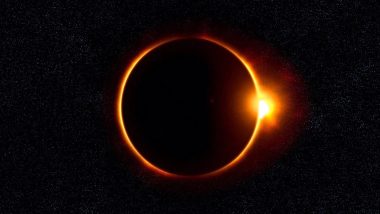New Delhi, June 20: An annular solar eclipse will occur on June 21. Several India cities, including Delhi, Mumbai, Bengaluru and Chennai will witness the celestial event. A Surya Grahan occurs on a new moon day when it comes in between the earth, and the Sun and all the three objects are aligned. An annular solar eclipse occurs when the angular diameter of the moon falls short of that of the Sun, and it fails to cover up the latter completely. As a result, a ring of the Sun's disk remains visible around the moon. People can check timings of solar eclipse here.
According to scientists, the Solar Eclipse of June 21 will start at 9:15 am and end at 3:04 pm in India. The maximum Eclipse will be at 12:10 pm. In Mumbai, the celestial event will begin at 10 am and the maximum Eclipse will be 11:37 and will end at 1:27 pm. In Delhi, the total duration of the Eclipse will be 3 hours and 29 minutes. Partial Eclipse will begin on Sunday at 10:20 in the national capital. People of the national capital can view the full Eclipse at 12:01 pm. Solar Eclipse 2020 Timing in Chennai: Partial Solar Eclipse to be Visible on Sunday From 10.22 AM to 1.41 PM.
Here Are Timings of the Eclipse in Some of the Cities of the Country:
| City | Starting Time | Maximum Eclipse | Ending Time |
| Delhi | 10:20 | 12:01 | 13:48 |
| Mumbai | 10:00 | 11:37 | 13:27 |
| Chennai | 10:22 | 11:59 | 13:41 |
| Bangaluru | 10:12 | 11:47 | 13:31 |
| Kolkata | 10:46 | 12:35 | 14:17 |
In India, the obscuration of the Sun by the moon at the time of greatest phase of the annular Eclipse will be nearly 98.6 per cent. Obscuration of the Sun by the moon at the time of the greatest phase of the partial eclipse will be around 94 per cent in Delhi, 80 per cent in Guwahati, 78 per cent in Patna, 75 per cent in Silchar, 66 per cent in Kolkata, 62 per cent in Mumbai, 37 per cent in Bangalore, 34 per cent in Chennai, 28 per cent in Port Blair.
Here Is The Video of Webcast of Solar Eclipse:
An annular solar eclipse occurs when the Sun, moon and earth line up in a manner that the moon blocks the Sun's light from reaching the earth. At this point, the moon is also at the farthest point from the earth, so although it does not completely block the Sun's surface, it forms an illuminated ring around, hence called as 'The Ring of Fire.'
(With inputs from IANS)
(The above story first appeared on LatestLY on Jun 20, 2020 09:21 PM IST. For more news and updates on politics, world, sports, entertainment and lifestyle, log on to our website latestly.com).













 Quickly
Quickly











